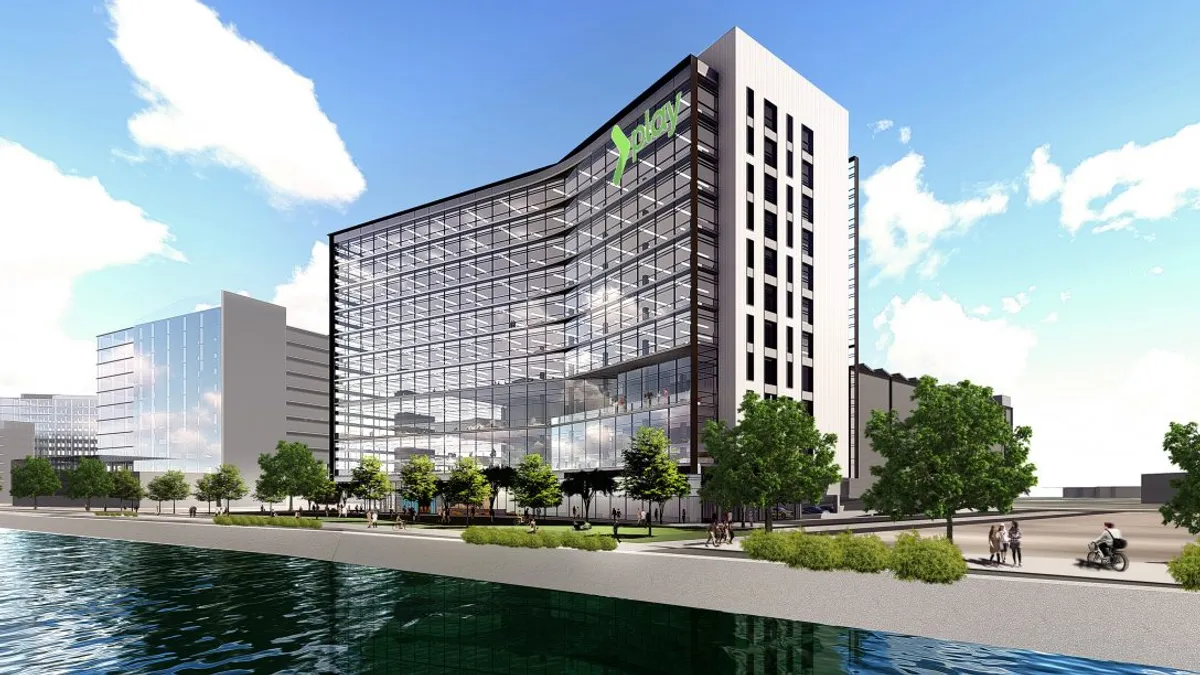While commercial and multifamily construction activity plummeted in the first half of 2020, one major metro area was spared.
Starts in the top 20 metropolitan areas posted a decline of 22% through the first six months of 2020 compared to the same period a year ago, according to Dodge Data and Analytics. After a normal start to the year, the drop began in March as a direct result of the coronavirus pandemic.
In Phoenix, however, construction starts leapt by 82% for the first half of 2020, according to Dodge. That equalled nearly $2.8 billion in project starts for the measured period. The increase, according to Dodge, was fueled by the start of some sizable projects, most notably the:
- $300 million Pier 202 mixed-use building (shown above).
- $125 million Adeline Residences at Collier Center.
- $200 million 100 Mill Ave office development.
- $115 million Park 303 warehouse building.
The only other city to show growth in the top 20 was Detroit, which saw starts increase by 96% to $929 million, less than half of Phoenix’s total.
Recession rebound
So what factors have kept Phoenix booming while projects in other large metros have been curtailed by COVID-19 challenges? There are several reasons, say local real estate experts.
First off, construction in Phoenix has appeared to prosper in part due to the prolonged impact on the city’s economy from the Great Recession. The economic downturn impacted Arizona more than other states, and up through 2015 it was still affecting business, according to Christine Mackay, community and economic development director for the city of Phoenix.
This means that starts are slowly inching back up from the doldrums of the Great Recession, more so than most major markets which had recovered.
In addition, in order to make the state more competitive, Arizona’s government cut red tape and enacted legislation, Mackay said. As a result of deregulation, the economic growth spurred new construction projects, including industrial, manufacturing, office and multifamily.
For example, in 2017 alone Gov. Doug Ducey’s administration eliminated or changed hundreds of regulations as part of a broad effort to streamline government. The repeals deal with everything from restrictions on reclaimed water, boat registrations, pharmacists and contractor licenses, according to AZ Central.
Since then, Phoenix’s uptick has been steady. The city had $1.3 billion in starts for the first half of 2017, and $1.5 billion for both the start of 2018 and 2019, according to Dodge. Notable names like Google, Apple and Amazon are among those that brought projects to Phoenix. The city’s attempts to attract new businesses combined with inexpensive land made Phoenix a much more viable option for large industrial projects.
“Phoenix was late to the party recovering from the Great Recession,” said Steven Betts, managing director of development for Holualoa Companies, a real estate management firm. “That turned out to be an advantage to the pandemic recession because we sat in the bottom of that recession for a long time. It forced this marketplace to rethink the business model of the economy.”
Essential construction
When the coronavirus pandemic hit, Ducey declared construction work essential. Doing so allowed major projects to continue, and enforcing safety practices on-site from the beginning helped construction stay on track throughout the early months of 2020 and the pandemic.
Key projects underway in the area are mostly industrial and manufacturing projects, Betts said. For instance, last month Amazon announced plans to create 3,000 new jobs in the Phoenix area for a new fulfillment center.
Phoenix has about 2.9 million square feet of office space under construction, according to Andrew Cheney, principal of Lee & Associates Arizona commercial real estate brokerage, with 1.3 million square feet of office space already pre-leased. Construction has continued on that space, Cheney said, though new starts for office projects are not as high.
The road ahead
Despite the progress that Phoenix is making this year, there are still challenges brought on by COVID-19. For instance, Arizona faced a large spike in COVID-19 cases in late June and early July. The number of cases has since dropped over the course of August and beginning of September.
Despite that peak, many of those interviewed for this article attribute the spike to people congregating in bars and restaurants, saying that construction was only affected minimally.
“We got overconfident,” Betts said in regards to the spike. “I think our reliance on personal responsibility was misplaced.”
Phoenix officials seem optimistic that the impact from the coronavirus on construction will continue to be minimal. As the state attracts new companies and remote work continues to become a viable option, Steve Lindley, executive director at Cushman & Wakefield, said the home buying market is “on fire” in Arizona, as people arrive from places like California, where the cost of living is higher.
The continued economic recovery makes Phoenix a city where workers want to live — because there are jobs — and because there is a robust workforce, more companies want to build, Mackay said.
“I am encouraged by preliminary signs,” Lindley said. “I am cautious because it’s definitely an uncertain world. But so far, people of talent who are coming and moving here, sometimes with jobs or remote jobs, or companies here, it encourages me that we could emerge from this stronger and better than other markets."





















